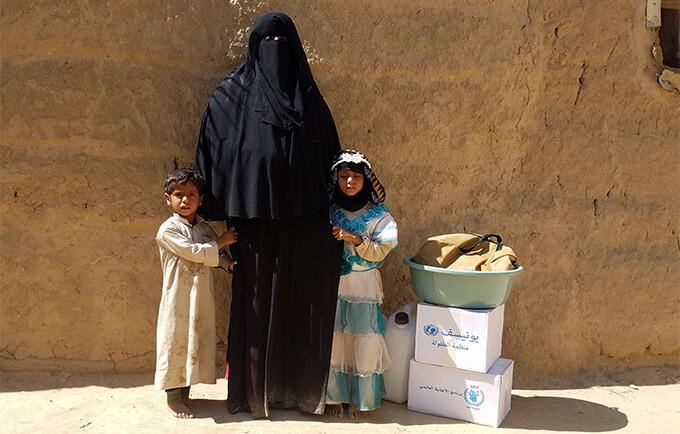UNITED NATIONS, New York/SANA’A, Yemen – When Yemen’s unrelenting conflict arrived in Taizz City late last year, Ashwaq saw her neighbourhood fall to pieces. Amid the bombardments, her house caught fire. She, her husband and their four children – including a son who is paralyzed – fled for their lives.
When they arrived in Sana’a, Yemen’s capital, Ashwaq found that the influx of displaced people had caused rents to skyrocket. She was unable to afford even the most basic accommodations.
Her family found temporary shelter with a relative. “There was not enough room for the six of us,” Ashwaq remembered. “We were all squeezed into a single bed. Within two weeks we searched again for a house. We were lucky to find a room and a bathroom in exchange for taking care of a larger house. However, we soon realized we were running out of money to buy daily essentials and medicines for our paralyzed son.”
UNFPA leads the Rapid Response Mechanism in Yemen, working with UNICEF and the World Food Programme. © UNFPA Yemen
Tragically, Ashwaq is only one of more than 168 million people in need of humanitarian assistance around the world.
“In 2020, lamentably, the world will face an unprecedented moment: 1 out of every 45 people will be affected by humanitarian crises. The stakes of inaction have never been so dire,” said UNFPA’s Executive Director, Dr. Natalia Kanem, in the organization’s Humanitarian Action Overview, released today.
Tens of millions of women and girls in crises
There are tens of millions of women and adolescent girls living through humanitarian crises today. Yet their reproductive health needs – including family planning information and care, maternal health care, access to menstrual hygiene supplies, as well as protection from, and treatment for, sexual and gender-based violence – are often overlooked.
And when these needs are neglected, the consequences are simply unbearable.
More than half of all the world’s maternal deaths take place in countries affected by crises and fragile conditions. Vulnerability to gender-based violence spikes in crisis settings, with risks ranging from domestic violence to rape as a weapon of war.
UNFPA works with partners around the world to address these needs. In 2020, UNFPA plans to reach an estimated 48 million women, girls and young people, including 4 million pregnant women, in 57 countries. The cost for this will be an estimated $683 million.
Yemen tops the list of countries with the greatest financial requirements for humanitarian assistance, with $100.5 million needed to meet the needs of women and girls.
The crisis in Yemen has continued for years without respite, leaving 80 per cent of the population in need of humanitarian support. As recently as last week, hostilities saw an escalation in Marib, Sana’a and Al Jawf, resulting in more than 9,400 new displacements. UNFPA responded with reproductive health clinics, able to support both natural and Caesarean deliveries, as well as deployment of medical teams and reproductive health supplies.
But underfunding of UNFPA’s humanitarian response in Yemen has threatened the agency’s ability to provide such life-saving support in recent years.
A critical moment
Ashwaq and her family were able to receive emergency support after a neighbour directed them to a local relief centre. There, supplies were being distributed through the Rapid Response Mechanism, a collaboration with UNICEF and the World Food Programme, led by UNFPA. The mechanism distributes critical emergency supplies, such as food and hygiene items, to crisis-affected communities within 72 hours of displacement.
The Rapid Response Mechanism, funded by donors including the European Commission’s Humanitarian and Civil Protection department and the Yemen Humanitarian Pooled Fund, operates in 330 of Yemen’s 333 districts.
“We are able to sustain ourselves with the food and essential items available in this relief package,” Ashwaq said. “My only wish now is to find treatment for my son.”
But longer-term solutions are still needed to secure the health, welfare and dignity of displaced persons in Yemen – and in all crises around the world.
“We had to leave everything behind,” Zahrah Mohammed Hassan, 18, told UNFPA. “I wish to have beautiful days like before and to return to our homes. I wish to live in peace with my child and no more wars.”



